Home | Category: Death and Mummies
OLD KINGDOM PHARAOH TOMBS
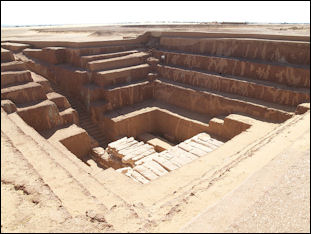
Balat mastaba tomb Mastabas are tombs used by early dynasties. They were often built to resemble a pyramid. They often had ramps that were reminiscent of the causeways that led from the Nile Valley to the pyramids on the high plateau and had attached but separate rooms where pottery and statues were kept. The deceased were often laid to rest in burial shafts. Mastabas are named after the Arabic word for “rectangular mud benches.”
Old Kingdom tombs were held up with cedars from Lebanon. The pharaoh's sarcophagi were chiseled out of southern Egypti granite and floated 500 miles down the Nile from Aswan.
Archaeologists found an ancient tunnel connecting two 4,000 year-old tombs to the tomb pharaoh Amenemhet I in Saqqara, Egypt. Scientists believe that the tunnels were created social-climbing Egyptian noblemen wanted to tap into the afterlife of the Pharaoh. Archaeologist Dr. David Silverman told AP: "Not only did they apparently feel thy were worthy, but they wanted to ensure they would have the best possible afterlife they could.
Categories with related articles in this website: Ancient Egyptian History (32 articles) factsanddetails.com; Ancient Egyptian Religion (24 articles) factsanddetails.com; Ancient Egyptian Life and Culture (36 articles) factsanddetails.com; Ancient Egyptian Government, Infrastructure and Economics (24 articles) factsanddetails.com
Websites on Ancient Egypt: UCLA Encyclopedia of Egyptology, escholarship.org ; Internet Ancient History Sourcebook: Egypt sourcebooks.fordham.edu ; Discovering Egypt discoveringegypt.com; BBC History: Egyptians bbc.co.uk/history/ancient/egyptians ; Ancient History Encyclopedia on Egypt ancient.eu/egypt; Digital Egypt for Universities. Scholarly treatment with broad coverage and cross references (internal and external). Artifacts used extensively to illustrate topics. ucl.ac.uk/museums-static/digitalegypt ; British Museum: Ancient Egypt ancientegypt.co.uk; Egypt’s Golden Empire pbs.org/empires/egypt; Metropolitan Museum of Art www.metmuseum.org ; Oriental Institute Ancient Egypt (Egypt and Sudan) Projects ; Egyptian Antiquities at the Louvre in Paris louvre.fr/en/departments/egyptian-antiquities; KMT: A Modern Journal of Ancient Egypt kmtjournal.com; Ancient Egypt Magazine ancientegyptmagazine.co.uk; Egypt Exploration Society ees.ac.uk ; Amarna Project amarnaproject.com; Egyptian Study Society, Denver egyptianstudysociety.com; The Ancient Egypt Site ancient-egypt.org; Abzu: Guide to Resources for the Study of the Ancient Near East etana.org; Egyptology Resources fitzmuseum.cam.ac.uk
Mastabas of Saqqara
Mastabas of Saqqara are tombs built for prominent Old Kingdom noblemen, officials and bureaucrats in an area also known as the Necropolis of Memphis. The tomb walls bear inscriptions showing scenes of everyday life in ancient Egyptian farming, animal breeding, hunting as well as religious rites and the offering of sacrifices to the dead. The Mastaba of Ptah-Hotep to the southwest of the Step-Pyramid contains numerous paintings and inscription, the most famous of which shows the ancient Egyptian philosopher Ptah-Hotep being entertained by a band of musicians. The Mastabas of Kagemni has mural reliefs with bird hunting scenes and the mastaba of Mereruka has inscriptions showing farming, hunting, craft making and veterinarians treating animals.
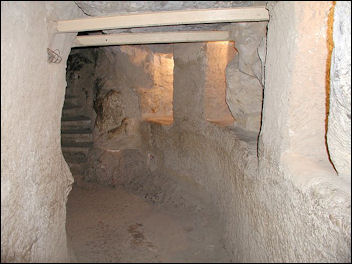
Cheops interior Excavations here have found the remains of officials in charge or medicine, gold and silver, housekeeping tools, canals and granaries. One inscription shows a teacher scolding a child for drinking beer instead of doing his homework. Another shows a teacher encouraging students to become scribes to avoid an adult life of labor and toil. Officials brag about the number of Nubian serfs at their disposal. Lovers express their feeling. One inscription reads: "He is like a datecake dipped in beer."
Saqqara (20 miles south of Cairo) is the home of ancient Egypt's oldest cemetery and was a religious center for the ancient capital of Memphis. Built on top of plateau that overlooks Memphis, it is famous for its mastabas (tombs) and step pyramids (the oldest large building in the world). Most of the buildings were built between 3,100 and 2181 B.C. The most famous of these is the Step Pyramid of Zoser, built in Third Dynasty of Old Kingdom for a pharaoh named Zoser (Djoser). It is possible to ride by camel from the Great Pyramids of Giza to Saqqara. This route passes by the pyramids of Abu Sir and Abu Gaurab that are otherwise difficult to reach.
Saqqara sits on the top or a barren, rocky escarpment above the green Nile Valley. It was established as a burial ground for Memphis. The cemetery area was huge. It stretched for 45 miles along the Nile. Many of the tombs are mastabas, which have been built above the ground. There was an entire cemetery devoted to mummified cats.
Burial Chamber in the Pyramid of Cheops
The 30-foot-high burial chamber in the Pyramid of Cheops is about halfway between the base and the summit. The 150-foot tunnel leading to the chamber is only four feet high, which means that people that enter it have to bend over to reach the chamber. Inside the King's chamber is a huge granite sarcophagus that is an inch wider than the entrance to prevent its removal. The lid which is slightly smaller than the entrance has been removed. To keep the dead Pharaoh cool the pyramid is even outfit with air vents.
The burial chamber in the Pyramid of Cheops is topped by five granite slabs and a pitched roof to prevent it from being crushed by the weight of the pyramid. Nearby is a chamber of unknown purpose originally thought to have been the queen's chamber. Exiting from both chambers are several narrow shafts that may have been built for the pharaoh's spirit to come and go.
The chamber was sealed from within by workers who exited through a tunnel that led to a subterranean shaft. Underneath the base is a chamber carved out of bedrock that may have been the original royal burial site. In spite of hidden entrances, granite plugs and walled-off passages, built in part to foil thieves, the pharaohs treasures were looted, most likely by fellow ancient Egyptians.
New Kingdom Pharaoh Tombs
New Kingdom Pharaoh tombs were designed to resemble houses in the other world and typically contained images depicting the journey of the deceased into the afterlife. Almost all the New Kingdom Pharaoh Tombs in the Valley of the Kings had an identical design. The chambers were chiseled out of bedrock with copper chisels and flint choppers from ceiling to floor, which means the ceiling dimensions are identical but the floor dimensions vary greatly. The room and corridors had names such as the First God's Passage, Sanctuaries in Which the God's Repose, and Hall of Hindering.
Most tombs were so elaborate that they took decades to build and were never finished. When a pharaoh died, the tomb was quickly fixed up — often with rooms being used for a purpose they were not intended for and unfinished paintings done in a rush — to accept the pharaoh.
The reliefs and paintings tended to be formulaic. Some tombs had a Hall of Truth, where the pharaoh's heart was weighed in judgement by Osiris, with the god Ammut ready to consume if it was lacking in character.
Valley of the Kings
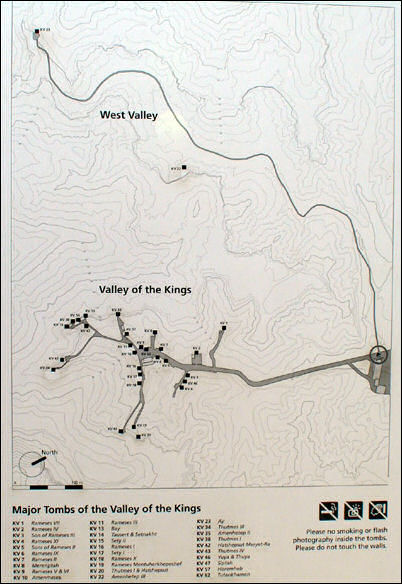 Valley of the Kings is the burial ground of the pharaohs of the New Kingdom, which ruled around 1500 B.C. to 1100 B.C. Known to the ancient Egyptians as “The Great and Majestic Necropolis,” the valley is surrounded by barren mountains, with largest being Al-Qurn (the Horn).
Valley of the Kings is the burial ground of the pharaohs of the New Kingdom, which ruled around 1500 B.C. to 1100 B.C. Known to the ancient Egyptians as “The Great and Majestic Necropolis,” the valley is surrounded by barren mountains, with largest being Al-Qurn (the Horn).
Made at a time when Egypt was at a peak in its wealth and influence, the tombs in the Valley of the Kings are carved deep into the rock faces of the valley walls and composed of several rooms and corridors leading down to the burials chambers. Artists and masons carved and decorated kilometers of underground corridors: not only for kings but also their wives, children and principal ministers. The tombs were once filled with unimaginable wealth, hinted at by the artifacts found in the tomb of King Tutankhamun (King Tut), who was a relatively minor king with a relatively modest tomb. The other tombs were all looted of their treasures millennia ago.
The tomb of Ramses II, arguably the greatest pharaoh of all, probably contained one of the greatest treasure hordes, but we will probably never know what those treasures were: his tomb was looted only 150 years after his death. Altogether more than 60 tombs are located in the Valley of the Kings. Archeologists have identified the probable resting places of 41 royals in 37 tombs (some tombs held more than one body) but in some cases the identity of the pharaoh that a tomb honors is unknown.
Almost all the New Kingdom Pharaoh Tombs in the Valley of the Kings had an identical design and were made using similar methods. The chambers were chiseled out of bedrock with copper chisels and flint choppers from ceiling to floor, which means the ceiling dimensions are identical but the floor dimensions vary greatly. The rooms and corridors had names such as the First God's Passage, Sanctuaries in Which the God's Repose, and Hall of Hindering.
Most tombs were so elaborate that they took decades to build and were never finished. When a pharaoh died, the tomb was quickly fixed up, often with rooms serving purposes they were not intended for, with paintings finished in a rush, to make way for the deceased the pharaoh.
Nobody knows why the Valley of the Kings was selected as the burial place for the New Kingdom pharaohs. Scholars speculate it because of the pyramid shape of el Quum, the mountains at the head of the valley, and the fact that the valley is a box canyon with an easy-to-guard entrance.
The Valley of the Queens is where most of the wives and children of the important New Kingdom pharaohs were buried. The tombs are similar to the tombs in the Valley of Kings in that they are carved into the rock faces of the valley walls of limestone cliffs and arid, eroded mountains, and are composed of several rooms and corridors leading to the burials chambers. Only five of the more than 70 tombs are open to visitors. The Valley of the Queens is closer to the ticket office than the Valley of the Kings. It is still a considerable distance from Luxor.
Books: “Complete Valley of the Kings” by Nicholas reeves and Richard Wilkinson (Thames & Hudson) and “Explorers and Artists of the Valley of the Kings” by Catherine Roehrig of Metropolitan Museum of Art (American University in Cairo-Press). Website: Theban Mapping Project: www.thebanmappingproject.com
Tombs in the Valley of the Kings
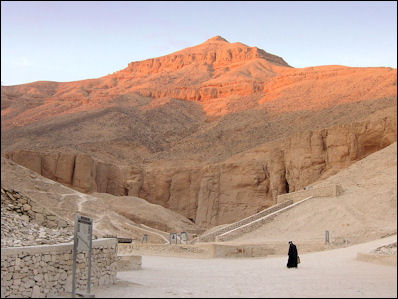 Tombs of Pharaohs in the Valley of the Kings include ones belonging to King Tutankhamun (King Tut), Ramses VI, Ramses IX, Tuthmomis III, Ramses VII, Ramses IV, Ramses II, Ramses III, Ramses I, Seti I, Amenhotep II, Tuthmosis II, Ramses III, Ramses VI, Tuthmosis IV, Amenhotep II and Seti II. The entire Thebean necropolis contains 4,000 to 5,000 tombs, of which only 400 have been given numbers.
Tombs of Pharaohs in the Valley of the Kings include ones belonging to King Tutankhamun (King Tut), Ramses VI, Ramses IX, Tuthmomis III, Ramses VII, Ramses IV, Ramses II, Ramses III, Ramses I, Seti I, Amenhotep II, Tuthmosis II, Ramses III, Ramses VI, Tuthmosis IV, Amenhotep II and Seti II. The entire Thebean necropolis contains 4,000 to 5,000 tombs, of which only 400 have been given numbers.
Assasif Tombs (between Hatshepsut's Temple and Tombs of Nobles) features paintings from everyday life and things like hunting and fishing. Three of the tombs are open to the public. They are the tombs of Kheru-Elf, Anch-Hor and Pabasa.
Tombs of Nobles (across the road from the Ramsesseum) has wall paintings that portray the lives of nobles and their families as well as scenes from everyday life . They are not as outstanding as those in the major tombs in the Valleys of the Kings and Queens.
Tomb of Nefer Sekheru (Tombs of Nobles) contains interesting images of everyday life. The Tomb of Nakt has some beautiful inscriptions and paintings of ibises, ducks, cats and butterflies. The Tomb of Mena features 3000-year-old wall painting that still retain their color. Mirrors are sometimes used to direct sunlight on the paintings. Mena was a scribe during the reign of Tutmosis IV.
Tomb of Sennefer (Tombs of Nobles) has broad square pillars and a ceiling and walls decorated with geometric patterns. One brightly colored scene show the blissful marriage of mayor Sennefer and his wife Meryet being performed under the watchful eye of Horus. Tomb of Ramose shows women supplicating themselves to their dead master. Ramose was a state official who worked during the reign of Amenhotep III and Akhenaten. The tomb contains inscriptions dedicated to Akhenaten and his wife Nefertiti.
Tombs of Pharaohs in the Valley of the Kings
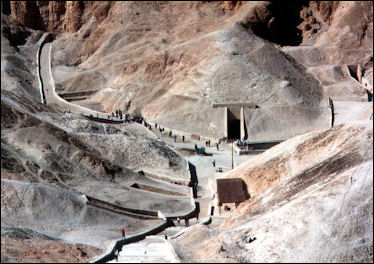 Tomb of Ramses IX is regarded the most beautiful, well-preserved and exquisitely crafted tomb in the Valleys of the Kings and Queens after the Tomb of Nefertari. It has an interesting depiction a pharaoh’s journey to the underworld. The Tomb of Ramses VI is regarded as almost as beautiful as the Tomb of Ramses IX. The Tomb of Ramses VI opened in the late 1990s after being closed for 40 years and undergoing restoration. Dated to the 12th century B.C., it contains well-preserved wall paintings depicting Egyptian history and a ceiling decorated with constellations. It also has some grafit from the Greco-Roman period.
Tomb of Ramses IX is regarded the most beautiful, well-preserved and exquisitely crafted tomb in the Valleys of the Kings and Queens after the Tomb of Nefertari. It has an interesting depiction a pharaoh’s journey to the underworld. The Tomb of Ramses VI is regarded as almost as beautiful as the Tomb of Ramses IX. The Tomb of Ramses VI opened in the late 1990s after being closed for 40 years and undergoing restoration. Dated to the 12th century B.C., it contains well-preserved wall paintings depicting Egyptian history and a ceiling decorated with constellations. It also has some grafit from the Greco-Roman period.
Tomb of Tutmosis III is one of the most-visited tombs in the Valley of the Kings by visitors with a three-tomb ticket. Reached by series of metal ladders, it is perched high in the valley about 400 meters from the other tombs. The Tomb of Seti I is the largest and most decorated tomb. The Tomb of Amenhotep II some say is the most beautiful tomb in the Valley of the Kings.
The Tomb of Amenhotep II contained side chamber where the mummies of Ramses IV, V and VI were found. In another chamber the mummy of a boy, young woman and older woman were found. The remains of the young woman had been badly mutilated. Some think the mutilated young woman may have been Nefertiti.
Ramsesseum (near Tombs of Nobles) is the mortuary temple of Ramses II. Built as an expression to his greatness, it has been desecrated and was scavenged for materials over the years and now lies mostly in ruins. It features painting of the pharaoh depicted as Osiris, the god of the afterlife, and murals of the Battle of Kadesh. The head of the multi-ton, 57-foot-high colossi of Ramses II that inspired the Shelley poem “Ozymandias” and guarded the temple were hauled away in 1817 by the Italian adventurer Giovanni Belzoni. He hired scores of Egyptians to drag the seven-ton heads to a boat that carried the heads up the Nile and eventually to London. The bust and other Belzoni "conquests" now form the core of the Egyptian collection at the British museum.
Tomb of Ramses Sons
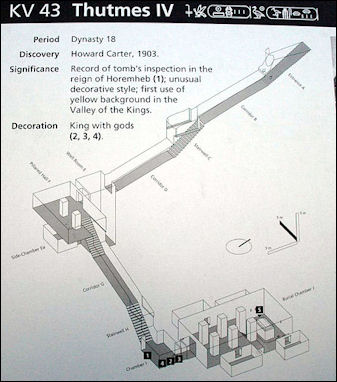
Tomb of Thutmose IV On February 2, 1995, American archaeologist Ken Weeks discovered a huge tomb with at least 108 chambers in the Valley of the Kings near Luxor. Archaeologists considered it the most significant discovery in Egyptology since the discovery of King Tut's tomb.
Known officially as KV5 (the 5th tomb discovered in the Valley of the Kings) and located about 100 feet from the tomb of Ramses the Great, the tomb is believed to have been a burial place for many of Ramses the Great' sons.
KV5 is the largest and most complex Egyptian tomb every discovered and the only multiple tomb for pharaoh's children. Inscriptions on the walls mentions two of Ramses' sons, which is what led archaeologists to believed it may be a tomb for his sons.
Describing the sensation of being in the tomb, Douglas Preston wrote in the New Yorker, "Nothing in twenty years of archaeology has prepared me for this great wrecked corridor chiseled out of the living rock, with rows of shattered doorways opening into darkness, and ending in the faceless mummy of Osiris...As I stare at the walls ghostly figures and faint hieroglyphics; animal-headed gods performing mysterious rites. Through doorways I catch a glimpse of more rooms and doorways beyond."
After being the first person to enter one chamber, "I sit up and look around....There is three feet of space between the top of the debris and the ceiling, just enough for me to crawl around...The room is about nine feet square, the walls finely chiseled from the bedrock...In run my fingers along the ancient chisel marks...Their only source of light would have been the dim illumination from wicks burning in a bowl of oil salted to reduce smoke.
Book: “ The Lost Tomb” by Kent R. Weeks (William Morrow & Co.) is the story of the tomb of the children of Ramses II.
Details about the Tomb of Ramses Sons
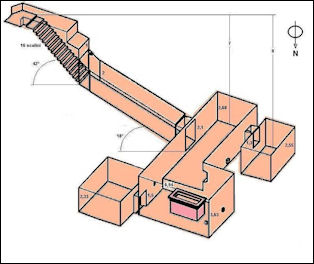
Tutankhamen's tomb KV5 has a T-floor plan and is made up of a series of boxcar-like chambers connected by corridors, and ending with a burial vault. There are a number of descending passageways and side chambers and suites and false doors. One of the largest chambers is sixty square feet. It is supported by four huge pillars arranged in four rows.
There are reliefs that show Ramses presenting various sons to the gods, with the names and tools recorded in hieroglyphics. Objects found include faince jewelry, fragments of furniture, pieces of coffin, humans and animal bones, mummified body parts, chunks of sarcophagi, remains of jars used for mummified organs — all debris left behind by looters.
The purpose of the tomb is a mysterious. Its design is radically different from other ancient Egyptian tombs. The rooms are not believed to have been burial chambers because the doorways are too narrow to admit sarcophagi. Instead they are believed to have been chapels where priest made offerings to the dead sons.
One corridors heads in the direction of the Tomb of Ramses and some scholars speculate that they might be connected. No two tombs are known to be connected. Some scholars believe Ramses's daughters might be buried in the tombs, others say that is unlikely. Archaeologists have found no evidence of Moses or the Exodus.
King Tutankhamen's Tomb
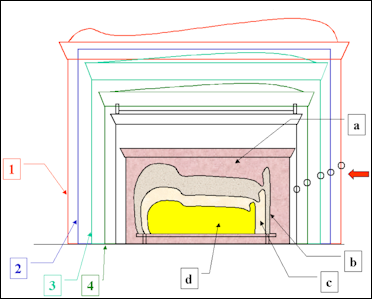
Tutankhamun shrines and sarcophagos King Tutankhamen's Tomb (Valley of the Kings) is one of the most visited tombs in the Valley of the Kings and has a separate admission price. Its discovery in 1922 was one of the greatest archeological discoveries of all time. Tutankhamen was only a minor king — he didn't build a pyramid or any great temples or monuments and he died before he was 21 — but it just so happens that his tomb was one of the few in the Valley of the Kings with a treasure missed by looters.
King Tutankhamun Tomb is located 26 feet underground. It was constructed from the relatively small unfinished tomb of courtier after the king died at an early age. Objects for the afterlife were crammed in the tomb and the paintings were so hastily prepared that splashes of paint that cover some of the images was not cleaned up. Some of the burial objects appear to have belonged to others (their names were erased and replaced with King Tutankhamun’s name).
Tutankhamen was well prepared for his trip to the afterlife. His four-room tomb yielded gold treasures; gilt coffins with images of the king emblazoned on the them; a glittering throne with palace scenes; effigies of gods and goddesses; a chest inscribed battles scenes; and jeweled daggers, earrings, necklaces and other riches. The most famous object found in it was Tutankhamun’s blue and gold funerary mask, which has been pictured in many books and magazines. All of these things are in the Egyptian museum, except when they are on tour.
Some painting in the tomb depict Tutankhamun funeral procession. After the funeral procession, his successor, Aye, symbolically revives the dead. Nut, the sky goddess welcomes Tutankhamun to the realm of the gods, and Osiris, god of the afterlife, embraces him along with his “ka” , or spiritual double. Baboons on the far wall represent the start of his passage through 12 hours of the night.
See Howard Carter and Discovery of Tutankhamun’s Tomb in 1922.
Two small female fetuses were found in the tomb. DNA testing in 2010 determined the they were Tutankhamun’s two still-born daughters.
Tomb of Nefertari
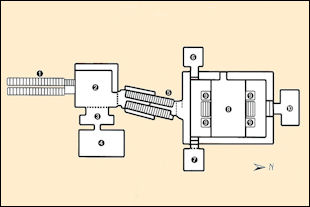
Nefertari tomb map Tomb of Nefertari (Valley of the Queens) is the most beautiful tomb in the Valley of the Queens or the Valley of the Kings and one of the most extraordinary works of art in the world. Over 3,200 year old, it is in amazingly good condition for its age and features extraordinary wall murals, painted with vivid colors, great skill and a wonderful sensitivity for detail.
Queen Nefertari was the favorite wife of Ramses II, arguably the greatest of all Egyptian pharaohs. Her name means "Beauty of Beauties." No expenses were spared to make sure she had the best tomb. The quality of art found in it far exceeds that of any other tomb in the Valley of the Queens or the Valley of the Kings. Some scholars argue that the murals contain the first examples of three-dimensional shading. The brilliant sheen of the colors has been attributed to glazes made from beeswax, tree resin and egg white.
Regarded as a close representation of the "House of Eternity," the tomb of Queen Nefertari is composed of seven chambers — a hall, side chambers and rooms connected by a staircase — and features paintings made on engraved outlines of humans, deities, animals, magic objects, scenes of everyday life and symbols such as ibis heads, scarabs, papyrus, lotuses, vultures and cobras.
The blue, orange and green murals describe Nefertari's journey to after life. Nefertari's images show up again and again. She appears in many of the murals is a sexy white gown and vulture headdress. Often in the company of individual gods, she is pictured doing various things like making offerings of meat, milking animals and steaming soup.
Marlise Simons wrote in the New York Times,"The effect is rich like a house hung with jewelry, and it has an intensity that appeals strongly to modern eyes. But what makes these galleries just as moving is the fine detail of the images, their exquisitely carved relief and the gestures of endearment that give the figures life...There is are sweetness and intimacy that makes contact across the centuries seem somehow possible."
Nefertari died at about the age of 40. Ramses II showed his love for her by hiring the best craftsmen and paying them enough so the tomb could be decorated in a grand style. Ancient graverobbers are believed to have taken her mummified body and the offerings of jewelry, furniture ad valuable object that are thought to have been buried with her. The only things beyond the tomb itself left for archeologists to find were a handful of artifacts, a few fragments of pottery and Nefertari's granite sarcophagus.
Nefertari's Tomb was discovered in 1904 by Italian explorer Ernesto Shiaparellu, who was surprised by the tomb's excellent condition. The tomb was and neglected until 1986 when it was restored by an international team with a $3 million grant from the Getty Conservation Institute of California. Nefertari's Tomb was opened to the public in November 1995. Initially the price of admission was a $100. Then it was lowered to $60. Now it costs about $30 to get inside.
Rooms in the Tomb of Nefertari
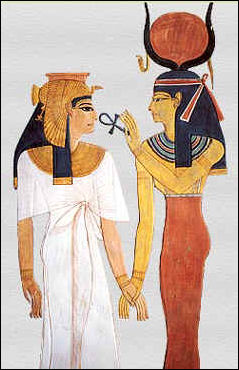
Nefertari tomb painting The top chambers show Nefertari preparing for her journey to the afterlife. The stairway downward from the upper chamber represents the journey itself. The bottom level contains the actual burial chamber. Here Nefertari is depicted being accepted into the afterlife world ruled by Osiris.
Antechamber in Nefertari's Tomb: Visitors enter through a door, chiseled in grayish, brown rock, that gives no indications of the wonders inside. After walking down a small series of stairs, visitors enter an antechamber. On the left is frieze and djed-pillars representing of the "blood of Isis." The first set of hieroglyphics are texts from Chapter 17 of the “Book of the Dead” .
There is a bench for offerings. Above its a depiction of Nefertari playing senet, a chess-like board game, in her tent. The game is associated with evil and witchcraft and is mentioned as a talisman in the “Book of the Dead” that is supposed to free the soul of the dead and help it on its journey to the afterlife. Here, Nefertari’s dress has fallen open, revealing her naked body.
On the right of the Antechamber is a vestibule with a djed-pillars with human arms and an image of the god Neith. Beyond the vestibule is the eastern Side Room, also known as the "Chamber of the Cloth." On the walls of the narrow opening between the two rooms are images of the Maat (the winged Goddess of Justice).
The paintings in the Eastern Side Room are among the most beautiful in the tomb. Looking towards the Antechamber, on the left, is a panting showing the union between Re and Osiris. On the right is an image of cloth being offered to Ptah. On another wall are the Seven Celestial Cows and the Four Steering Oars with texts from Chapter 148 of the “Book of the Dead” . On the opposite wall is the magic formula for obtaining the water bowl and scribe's palette from Chapter 94 in the “Book of the Dead”.
In this room is the most impressive portrait of Nefertari. She is wearing a transparent white gown, lotus bud earrings, a wide golden collar and a vulture headdress, adorned with a sun disk and double plumes.
Burial Chamber in Nefertari's Tomb
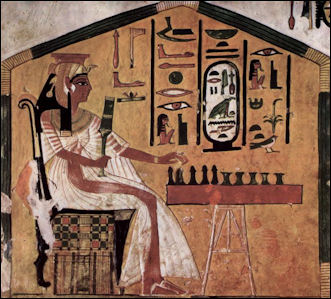
Nefertari tomb painting The Stairway Corridor in Nefertari's Tomb leads down from the Antechamber to the Burial Chamber. The slipway ramp (where there are no stairs) was used to lower the sarcophagus into the Burial Chamber. On the left, before the stairs, are Cartouches (rectangles with a horizontal line at one end) before the goddess Nekkhbet and on lotus flowers.
As Nefertari proceeds in her journey through the nether world, she comes in contact with different gods and acquires their power and then carries their symbols with her. As she proceeds to the afterlife she reaches gates guarded by specific gods and is allowed to pass after she says the guardian’s name.
On the left, as one begins walking down the stairs, are images of the goddess Selkis and Nefertari in her white robe, making an offering to Isis. After Isis are images Nephthys and Maat (with the wings under her arms). Underneath the images are texts from the “Book of the Dead” . Towards the bottom of the stairway, on the left, is Anubis, the god of Mummies, depicted as a seated jackal. Below him is an image of Isis (with white hair and red dress), kneeling on the Nébu, the symbol gold.
The Burial Chamber in Nefertari's Tomb is a large room supported by four pillars, with benches and a wall painting. The central part of the chamber is lower than the southern and western sides. On the southwestern side is a djed-pillar and an image of Osiris. On the southeastern side is djed-pillar and an image of Nefertari with Isis. On the northwestern side is an image of Osiris and another of Nefertari with Hathor-menet. On the northeastern side are images of Nefertari and Anubis, Nefertari and Isis.
On the west wall is a large image with three figures — the guards to the gates of paradise. The horned and goat-headed god is Khanoum. The lion-headed god is Sekhnet. The third is a human figure. Each carries a dagger to keep evil spirits from entering the tomb in accordance with talisman 144 of the “Book of the Dead” .
Ancient Egyptian Priest Tomb
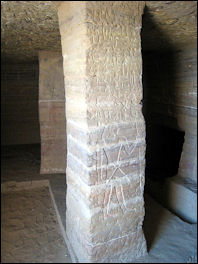
Inside a tomb In 1996, the undisturbed and unlooted 2,500-year-old tomb of a high-ranking priest named Iuffa was discovered by archaeologists for the Czech Republic's Charles University in Abusir at a a site about five mile south of the Pyramids of Giza. The coffin was situated at the bottom an 84-foot-deep shaft. It was surrounded by an inner sarcophagus and outer sarcophagus that was placed on a pile of sand in the shaft and had been lowered by removing the sand to other shafts. After the sarcophagus was lowered a vaulted stone chamber was built around it. The door was sealed and the sand was deposited in the shaft. [Source: Zahi Hawass, National Geographic, November 1998]
So difficult was the project to excavate the tomb, archaeologists spent three years extracting the sarcophagus from the shaft and open the coffin. Beams and jacks and laborers pulling chains were used to pull the lid off the sarcophagus. The project wasn't completed until 1998.
Filling most of the burial chamber, the box-shaped white limestone outer sarcophagus was 16 feet long and 11 feet wide. The lid alone weighed 24 tones. Along the sides of chamber were tomb furnishings four canopic jars with internal organs. The jars looked like coffins and bore likenesses of the priest’s head.
Inside the outer sarcophagus was a layer of mud bricks and mummy-shaped plaster. The sarcophagus was made from gray basalt and covered with fine carvings and hieroglyphics. Inside was a decayed wooden coffin that turned to powder with a touch. Inside it was mummy covered with a shroud filled with glazed ceramic beads organized in patterns depicting gods of the afterlife such as Nut and the sons of Horus. Moisture had penetrated the coffin so the mummy crumbled to powder with a touch. The mummy's fingers were sheathed in gold.
Hieroglyphic identified Ifuaa as a lector priest and an administrator of palaces. He was a member of the elite class and is believed to have assisted gods and kings and read spells and performed rites. He lived during a period of Egyptian cultural revival and died during the Persian occupation.
Ancient Egyptian Tombs of Commoners
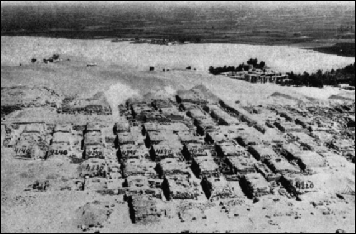
Chephren Cemetery seen from the Second Pyramid Commoners generally weren't mummified or were only slightly mummified. Mummification was mostly reserved for royalty and nobility. Most were buried with and few or no grave goods in the fetal position in simple shrouds or jars with the top of the skull aligned toward the north and the face pointing east towards the rising sun. Wooden coffins were too expensive for most commoners. Many were buried in the sand on placed in a hole.
Some had tombs. The tombs of the pyramid builders consisted of vaulted chambers with small gabled openings. The tombs came in a variety of forms: stepped domes, beehives, gabled roofs, simplified pyramids (some even had ramps, which may have represented ramps used to build the real pyramids). Hawass found one tomb with an "egg-dome" (a mud brick outer dome with an egg-shaped corbeled vault) built over a rectangular pit.
Some of the tombs of the pyramid builders had false doors, crude hieroglyphics and multiple chambers, one for each family members, and courtyards with granite and diorite walls. This shows that their tombs had some features previously only associated with the tombs of nobility — but in cases they were made from mud brick rather stone. At the upper part of the cemetery for the pyramid builders were the people with the highest status. They had titles like "director of the draftsmen," overseer of the masonry," “director of workers,” and "inspector of the craftsmen."
Often multiple burials were found in a single grave. Often two adults and one or two children were buried together, or several children were buried with a single adult. In 1991, children and infants were found in Abyos buried under a house dated to the to around 2000 B.C. Three were newborns interred in pots. A forth was found lying under a bowl on top of a toddler.
Tombs of commoners often provide important information for archaeologists because they have usually been undisturbed by grave robbers who know they would be unlikely to find anything of value inside.
Image Sources: Wikimedia Commons, The Louvre, The British Museum, The Egyptian Museum in Cairo
Text Sources: UCLA Encyclopedia of Egyptology, escholarship.org ; Internet Ancient History Sourcebook: Egypt sourcebooks.fordham.edu ; Tour Egypt, Minnesota State University, Mankato, ethanholman.com; Mark Millmore, discoveringegypt.com discoveringegypt.com; Metropolitan Museum of Art, National Geographic, Smithsonian magazine, New York Times, Washington Post, Los Angeles Times, Discover magazine, Times of London, Natural History magazine, Archaeology magazine, The New Yorker, BBC, Encyclopædia Britannica, Time, Newsweek, Wikipedia, Reuters, Associated Press, The Guardian, AFP, Lonely Planet Guides, “World Religions” edited by Geoffrey Parrinder (Facts on File Publications, New York); “History of Warfare” by John Keegan (Vintage Books); “History of Art” by H.W. Janson Prentice Hall, Englewood Cliffs, N.J.), Compton’s Encyclopedia and various books and other publications.
Last updated September 2018
